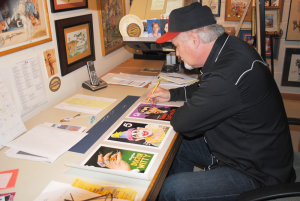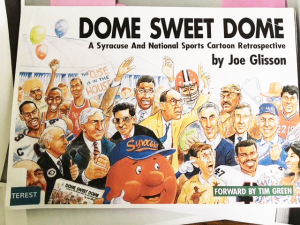A Life Story, With Illustrations
Joe Glisson, 60, keeps drawing on his artistic talents
By Mary Beth Roach
 Joe Glisson amused Syracuse New Times readers for decades with his cartoons that good-naturedly poked fun at local sports and political celebrities.
Joe Glisson amused Syracuse New Times readers for decades with his cartoons that good-naturedly poked fun at local sports and political celebrities.
His posters of various Syracuse University sports teams hang on walls in taverns, game rooms and “man caves” throughout the area. Some of his cartoons live on in his books, “Dome Sweet Dome,” “Seems Like Old Times” and “No Place Like Dome!!”
Today, Glisson’s creativity has gone 3-D and has become larger than life. He calls it “three-dimensional composing.”
One of these projects stands about 6 feet tall and greets visitors to a local restaurant.
Yes, he is the creator of Tully’s Good Times Turtle, and designs the interiors of all the Tully’s restaurants. He’s also worked with Tully’s owners, the Giamartino family, to design their CopperTop Tavern and Good Buddy’s Pub, and is responsible for the installation of all the memorabilia on the walls, from purchasing to hanging it.
“My career has transformed a little the past five, six, seven years,” he said. “There’s not enough illustration work for an individual to make a living off. I had to transition.”
How Glisson came to land the Tully’s job in 1993 — and so many others throughout his illustrious career — came by pitching himself.
“You have to hustle,” he said. “You don’t have to be that good. I was not the best artist in Syracuse, so forget about the rest of the country.”
But he was consistent and met deadlines, and that was critical to art directors.
“I was so driven in a way,” he said, adding that if his mother, Dode, were alive she’d say, “‘You couldn’t tell Joe anything. Joe had his own way of doing it. He wanted what he wanted.’”
“For good or bad, that was pretty much true,” he noted. “If I wanted something, I went after it. I didn’t always get what I wanted.”
He may not have always gotten what he wanted, but the pursuit has marked Glisson’s career and the success he has found.
Take the Tully’s work for example. When he had heard that Tully’s was going to open a new restaurant on Erie Boulevard and it had a sports theme, he packed up some of his original art pieces and went down to talk to the owner.
When arriving at the restaurant, he showed the owner, John Giamartino, his artwork, and Giamartino bought it all.
Glisson noticed that they already had quite an inventory of sports memorabilia due to go up on the walls of the restaurant. Being the sports fan that he is, he began looking through the artifacts.
“The fan in me really wanted to see this stuff. Infamously I asked, ‘Who is hanging up all this stuff?’ And he said that he was. And I asked, ‘Is this something you like to do?’ He said, ‘No, I hate it,’” Giamartino said.
So I asked, “Would you like some help? He said, ‘I would love some help.’ And that was the beginning of a beautiful relationship,” Giamartino said.
But knowing his strong suit is the visuals in the restaurant, and not the food prep, he stays away from the kitchen.
“I don’t go anywhere near the kitchen. I don’t even go up in my kitchen. My wife won’t let me,” he said with a chuckle.
His work at Tully’s — and his whole artistic career — most likely has its roots in his childhood.
His father, Bill, had made corkboards for his and his brothers’ bedrooms. “It started this thing in the family that you would cut out pictures and arrange them in an artistic fashion. I was composing and didn’t even know it,” he said.
Although he’s been drawing since he was a youngster, he had no intention of becoming an artist.
“I think before I was 6 years old, I had the tools to do everything I’ve done. In a big family, I was drawing anniversary and birthday cards constantly,” said Glisson, the fifth of seven boys. “I remember lying on the hardwood floor, just always drawing cards, and there weren’t posters of Spiderman or Batman. If you wanted a poster of Spiderman, you had to draw it. I was doing that,” he said.
Sibling rivalry
Growing up with six brothers, there was a sense of rivalry, he noted, and since four of his brothers were better artists, he decided he was going in a different direction. “Boys are competitive,” he said. “We’re not going to do the same thing.”
He ended up going to Le Moyne College in Syracuse, getting a degree in business. While there, he also became the art director for the school’s The Dolphin newspaper. But by the time he graduated, his older brothers had taken up different career paths, none of them in art, so Glisson decided to pursue that field.
He eventually made his way to the Disney Studios in California, but soon realized, for a variety of reasons, that its wasn’t a good fit for him, so he was back in Syracuse within a year.
He decided to give himself six months to find a job as an artist. If he could begin to make money illustrating, he would continue. If not, he said, he’d do something in the business world.
Through one of his friends from his days at The Dolphin, who was working at the time at the local Eric Mower and Associates Agency, he was able to get a job at the local advertising firm.
The pace was grueling, but the pay was good. He was doing so well that within a few years he was able to buy a home in Jamesville, where he still resides and has his studio, and established Joe Glisson Productions.
Eventually, some of those art directors from Mower would move on to bigger markets, but they would often reach out to Glisson on projects.
“With Federal Express and fax machines, I didn’t have to move down to a major city, which was good because I never would have, but I could get some of those big jobs,” he said.
While Glisson loved the freelance work, he wanted to do other projects that interested him. “It got to a point where I wanted to do what I wanted to do and get paid for it,” he said with a chuckle. “How can I do that?”
Of course, he figured out a way.
“I like to draw and paint. I like sports. I grew up on Sports Illustrated. The natural thing was to do some Syracuse University stuff,” he said.
Although he knew that the university didn’t use illustration, he had a connection, Mike Holdridge, who handled the sports program covers.
Glisson did a cartoon drawing of the late football coach, Dick MacPherson, and took it to Holdridge on speculation. While Holdridge liked the work, he was a little hesitant to use it since they had never used drawings before. Glisson told him he would give it to him to use for free.
“Well, it ended up on the cover. And then, the coaches saw it, and thought that was pretty cool,” he noted.
That led to another cover and then basketball covers. And then, men’s basketball coach Jim Boeheim asked him to do his team’s posters, which he did for seven or eight years.
He would go on to do the women’s basketball team poster, then the basketball office’s Christmas cards, media guide covers for the football team, and their captains’ portraits.
And when “The Express” movie, about SU football great Ernie Davis, premiered at the Landmark Theatre in downtown Syracuse, he was asked, with nothing more than a week’s notice, to create a portrait of Davis.
The university, he was told, wanted to present the film’s director with a portrait of Davis before the start of the show. No stranger to tight deadlines, Glisson completed the portrait on time.
Tight with SU
 He has had a long affiliation with SU over the years.
He has had a long affiliation with SU over the years.
While working part time as a graphic artist in the graphics department at University College, he was invited to take part in a master’s program at UC.
The program was selective, only taking eight students a year. It was an independent study, meeting once in the spring and once in the fall in a major city and then two weeks on campus.
Glisson said he wasn’t interested until he saw the faculty list was comprised of visiting professors that were some of the major illustrators in the country.
“I made the comparison that it was like if I were playing for the Auburn Doubledays and somebody came up and showed me a picture of who I might be able to play with, and it was Babe Ruth, Lou Gehrig and the ’27 Yankees. That’s the way I felt,” he said.
So he signed up for the program, and it was a decision that would change his life.
While in New York as part of the study, he met his future wife, Linda. The pair has been married since 1984, have four children and have fostered 28 children, adopting two of them.
A few years later, an adviser in the independent study Master of Arts program in illustration at SU, Murray Tinkelman, would invite Glisson to become an adjunct professor in illustration at SU, which he did for nearly two decades.
The famed illustrator would also become one of Glisson’s mentors, and Glisson recalled a conversation he had with Tinkelman about how the process of taking on projects that he wanted to do.
“He said, ‘Well, do it. That’s what I do.’ And that was true. So I thought about it. What would I do a painting of? What do I like? And I remember when I was 6 years old, I loved Roy Rogers,” Glisson said.
So about 30 years ago, Glisson did a painting of his cowboy hero and sent it to Rogers. Lo and behold, much to Glisson’s surprise, Rogers’ agent called him and asked him if he’d be interested in mass-producing this image.
“I was too old to be Roy Rogering it,” he said, laughing. But he did, producing a limited issue print. Rogers signed them all, and they sold out quickly.
Soon people were calling him, he said, asking him who was going to be the next cowboy he did. Although he hadn’t been interested in doing more cowboy art, he followed up by doing the Lone Ranger and Hopalong Cassidy, but he has since reined in that part of his career.
New Times veteran
The Syracuse New Times was another contact from his days at Le Moyne and The Dolphin — and a little bit of hustling — that would lead him to the publication that has probably brought him the most fame locally.
His Le Moyne buddy went to work on a magazine for one of the unions, and hired Glisson to do a cartoon for the publication once a month.
This would eventually lead to some covers. While the money was OK, Glisson said he was looking for a bigger audience.
So, upon getting permission to re-run these cartoons, he went to the Syracuse New Times.
The publisher had first agreed to run two. “That was the foot in the door,” Glisson said. That was in the mid-1980s, and it was a relationship that would last about 30 years.
The cartoons would become a favorite for many New Times’ readers.
But changes at the New Times and a feeling that he might be getting a little stale caused Glisson to give up the weekly cartoon.
“I was repeating myself,” he explained. “Every decade, there’s a gas shortage, there’s a president nobody likes, there’s some kind of political scandal, and the economy goes into a recession.”
Some of those cartoons and others are featured in the books he’s published.
He said during his career which has spanned more than 35 years, he has done 3,000 illustrations, everything from billboards to record covers.
The walls of Glisson’s studio in the basement of his home in Jamesville are covered with artwork that shows off his range of talents — from posters and Christmas cards done for SU to a Norman Rockwell-like portrait of a little boy with a pumpkin, from Roy Rogers to a stunning portrait of Walter Mondale, the Democratic Party’s presidential candidate in 1984.
The Mondale piece was supposed to be a Time magazine cover. But by the time it was to go to press, another story broke which made Mondale expendable, and Glisson was paid a kill fee.
Of his ability to do different styles, Glisson said that in a secondary market like Syracuse, that can work in one’s favor.
In New York, back in the day, he explained, if artists were proficient in different styles, it could work against them because there was a belief that they weren’t working hard to be the best in anything.
Has his success surprised him?
“The call from Roy Rogers’ agent, that surprised me,” he said, adding that as he gets older and looks back on his career, perhaps he’s more surprised.
In looking back, Glisson sees the major changes and shifts in the illustration business, especially in how the drawings are produced and how seldom they are used.
“If you’re an illustrator, you have to charge a certain amount to make a living. So per piece, it’s going to be more expensive for a client than if he gets a piece of generic art off some of these [online] sites,” he said. The rise of Macintosh computers and iPhones has enabled many people to take their own photos.
“It’s ironic, with the advent of the Mac and all this technology, you would think things would get better quality-wise, when in my opinion, when the Mac came out, the agency went from 12 art directors to like three because you could do so much more on the thing,” he explained.
In an earlier era, art departments could tell clients they’d have three sketches to them in 10 days, giving the artists time to come up with ideas and design them. Now, technology is such that everything is done quicker — and Glisson said sometimes quality suffers.

